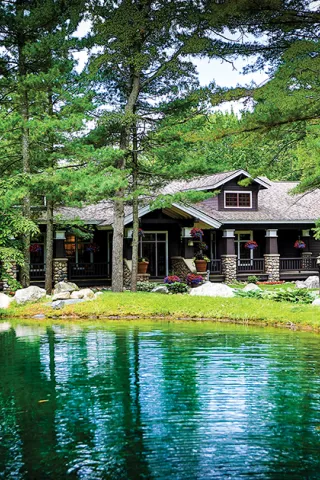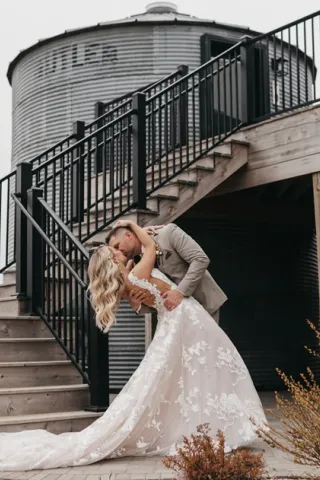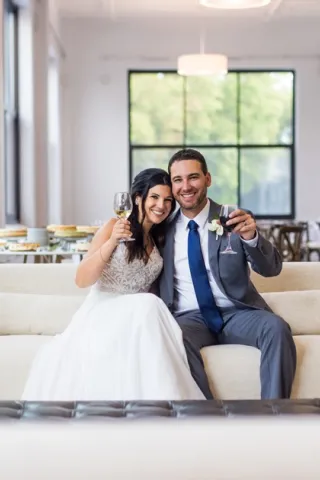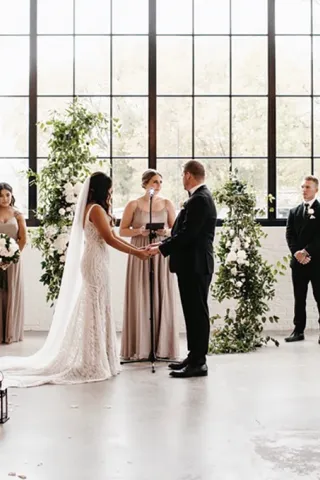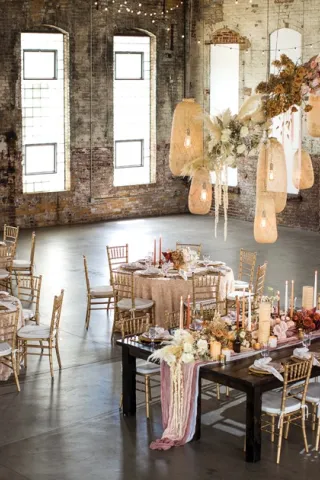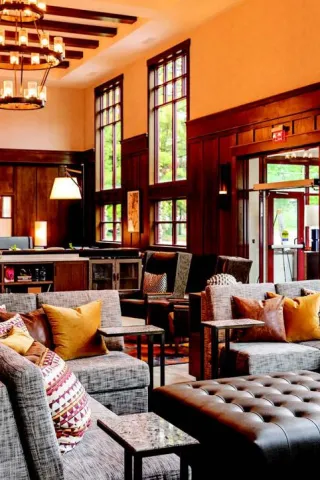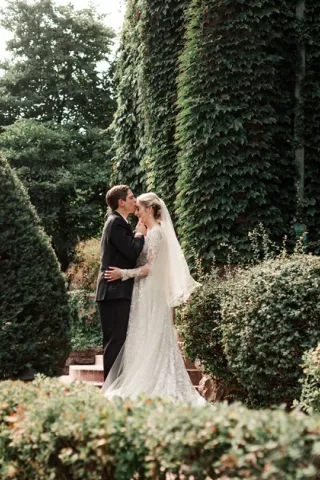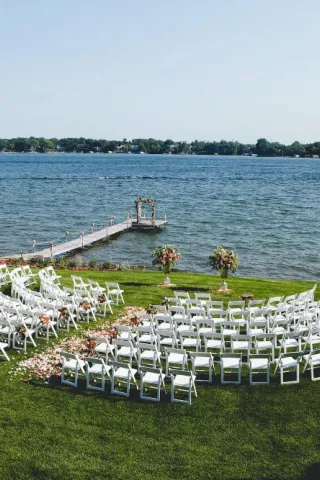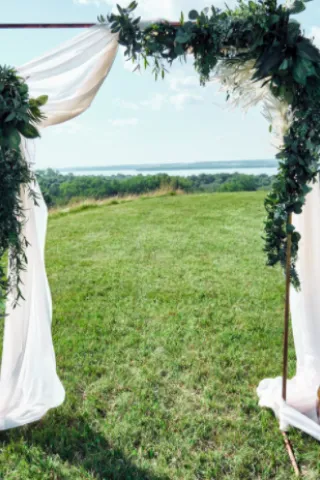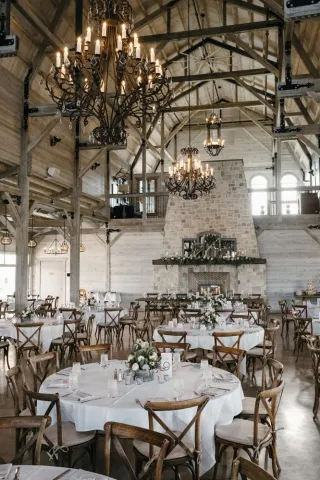When Jenna Kutcher was looking around Duluth for the perfect wedding venue, a story stuck in her mind: Back in 1909, a young Finnish girl named Sophia came through Ellis Island and made her way across the United States until her train finally pulled to a stop at Duluth’s regal train depot. That young girl was Jenna’s great-grandmother, and more than 100 years later, Jenna saw the historic Duluth Depot and knew it would be ideal for her wedding. “My mom told me the story of my great-grandmother before we booked the Depot, and I knew I wanted it to be part of our wedding,” she explains.
Historical Inspiration
Thinking outside the traditional hotel-and-banquet-hall box has prompted many brides to turn to historical venues for a new twist on the typical wedding. In Jenna’s case, a simple story of family lore evolved into a vintage wedding theme inspired by the Depot’s historic significance for her family. They carried that theme into the details: her grandfather drove Jenna and husband Drew to the reception in his 1941 Chevy coupe, the same baker who made her parents’ wedding cake baked Jenna’s, and family artifacts like her grandfather’s cigar box and old family photos were prominently displayed at the reception.
“It was very vintage,” says Jenna. “The retro theme and historic space let us highlight the great marriages that came before us.”
Much like Jenna and Drew, couple Tim Gihring and Lucy Lyon found themselves taking inspiration from historic spaces. After deciding against a traditional church wedding, the couple struggled to put together a day that would hold meaning for their families and guests. “If you’re not doing the traditional church wedding, how can you add weight, some gravitas, to the day?” says Tim.
After the couple toured the opulent Turnblad Mansion at the American Swedish Institute [ASI] in Minneapolis, an idea was born: Lucy is of Swedish descent, and the distinguished mansion would help the pair honor that history within her family. The wedding planning instantly took a turn for the Swedish: colors of the country’s flag were to be incorporated into the flowers, and Lucy planned to wear a traditional Swedish bridal crown (rented from ASI) as she walked down the aisle.
“Plus it doesn’t hurt that the Turnblad is a castle,” adds Tim, who was also delighted that the ASI offers docents for the whole evening, allowing guests to take official tours of the venue.

Photos by DnK Photography
An Air of Elegance
In addition to built-in inspiration, historic venues also come with a level of readymade elegance—no additional enhancement needed. Bride Ruthie Baker-McGrath, an actress by trade, is the first to admit that she’s a dramatic person and, as such, her wedding venue needed to reflect that spirit.
“I wanted a place that would make me gasp,” she explains when describing her wish list for a venue. One step inside the marble-laden James J. Hill Library in St. Paul, and gasp was all she could do. “I knew a ballroom at a hotel wasn’t for me,” says Ruthie, who fell in love with the library’s classic Georgian architecture and high ceilings. “At the library, I could let the venue speak for itself and wouldn’t need to gild the lily with lots of decoration.”
Bride Bridget Ho, who had a large guest list to consider, was also drawn to a dramatic venue with a lot of character: the Mill City Museum. Built inside the ruins of an old flour mill on the Mississippi, the venue oozed the kind of uniqueness that couldn’t be recreated by florists or decorators.

Photos left by lauren b photography
“Historic venues generally have more character, charm and interest,” Bridget says. “And because the building looks amazing on its own, we didn’t have to do a lot of decorating.” Instead the couple could take advantage of the special features the historic venue offered, including an outdoor courtyard and photographs that portray the flour mill’s history as part of Minneapolis’ rise as “Mill City.”
Things to Consider
With the charm and elegance of an older venue often also comes a list of strict parameters that weddings must operate within to preserve the historic space. Lucy Lyons and Tim Gihring encountered this firsthand at the American Swedish Institute’s Turnblad Mansion, when they learned that their cocktail hour could only feature non-colored beverages like white wine, clear sodas and champagne to avoid any red wine or cola-meets-carpet disasters. “It was surprisingly easy to work with that,” says Tim, who considers the restriction a fair trade-off for his guests having access to the entire ASI campus with beverage in hand.
In St. Paul, the Landmark Center is one of the city’s most recognizable historic buildings, and as such, it remains open to the public on Saturdays until 5 p.m. “You’re definitely not going to have the place to yourself until exactly 5 p.m.,” explains bride Lara Page, who prepared for her wedding while tourists wandered throughout the open building. Lara also found she couldn’t rehearse her wedding in the actual space where it would take place; floating candles were also verboten.
The restrictions weren’t a problem for Lara, who suggests that brides in a similar situation maintain a list of the venue’s restrictions that they can refer to throughout the planning stages. “Write down all the rules about timing, decorations and what’s allowed, because [otherwise] you’ll forget,” says Lara. “If you can, hire vendors who have worked in the venue before, because their experience is invaluable. You don’t have to give them directions because they know the rules and just make it happen.”
At the James J. Hill Library, candles are (sensibly) not allowed near the bookshelves, and glitter, bubbles and confetti are also a no-no. For Ruthie Baker-McGrath, the restrictions weren’t a sacrifice considering how stunning the space is. “We had no problem working within their rules,” she says. “It’s nice to be respectful and courteous of historic property.”
Each bride found that the payoff for following stricter rules came in the form of awed guests. “I was told by a lot of my guests that the library was the most elegant venue they’d been to,” says Ruthie.
Lara fielded equally impressed feedback. “I heard nothing but amazing reviews about the venue; everyone thought the Landmark was well-preserved and gorgeous,” she says. “It was the perfect, elegant wedding atmosphere.”
A Historic Venue Primer
- American Swedish Institute
Housed in the ornate, castle-like Turnblad Mansion (built in 1908), the ASI has recently added a new state-of-the-art Cultural Center next door.
Capacity: With the Turnblad Mansion, Nelson Cultural Center and courtyard to choose from, capacity ranges from 80 to 250 for a sit-down dinner.
Catering: ASI recommends five vetted caterers, but will allow brides to bring in caterers of their own choosing upon approval.
Minneapolis, 612.871.4907, asimn.org
- Landmark Center
Originally the federal courthouse and post office, the Landmark Center opened in 1902 and played host to the famous 1920s gangster trials. In the 1970s it was placed on the National Register of Historic Sites and re-opened to the public as the Landmark Center in 1978.
Capacity: The cortile (atrium) holds 320 for dinner and dancing; the courtrooms vary in size and can host 50 to 80 people for dinner.
Catering: Outside catering allowed, and the building has a liquor license.
St. Paul, 651.292.3228, landmarkcenter.org
- Duluth Depot
Built in 1892, the Depot’s Great Hall has ceilings that soar to 88 feet, featuring two huge fireplaces at each end of the hall.
Capacity: Up to 250.
Catering: Open; brides may choose any licensed caterer.
Duluth, 218.727.8025, duluthdepot.org
- James J. Hill Library
An Italian Renaissance-style library that features pink Tennessee marble and Kettle River sandstone, the library opened to the public in 1921 and was entered on the National Register of Historic Places in 1975.
Capacity: 220 for receptions, 150 for ceremonies with a reception, 350 for a cocktail-style affair.
Catering: The library has an open catering policy; there is a list of preferred caterers, but guests may hire any licensed and insured caterer.
St. Paul, 651.265.5447, jjhill.org
- Mill City Museum
Built in 1880 and once considered the world’s largest flour mill, the Washburn A Mill was almost destroyed by fire in 1991. It is now a National Historic Landmark after being restored by the Minnesota Historical Society.
Capacity: 230 for a plated and served dinner, 170 for a buffet, 800 stand-up reception style.
Catering: Exclusively D’Amico Catering, which also handles the event space.
Minneapolis, 612.238.4444, millcitymuseum.org
